Looking for Scribie vs. Rev review? If so, below is our in-depth comparison to give you all the information you need.
If you have done freelance transcription before, you know that there are no two different sites that are exactly the same. One will offer a better-earning potential per task.
The other will counter with better work availability. Sometimes, one site will be better at all the important aspects.
This Scribie vs. Rev comparison will discuss two of the most popular transcription platforms for freelancers.
We shall look at the tiny details that separate them and try to find the overall winner from a transcriptionist’s standpoint.
The idea is to save you the need to research them yourself and help you launch yourself into transcription with realistic expectations.
And . . . we dive right in!
What Is Scribie?
Scribie bills itself as the most advanced transcription service on the internet.
Whether that’s true or false is another thing, but with over 50,000 transcriptionists, we can at least confidently describe it as a top-shelf service with some decent market share.
Scribie offers two types of services: manual transcription and automated transcription. Transcriptionists like you do manual transcription.
Automated transcription, on the other hand, is done by machines and may require corrections afterward if need be.
As a transcriptionist, you will receive audio and video clips and be asked to transcribe them within a certain period and for a predetermined amount of money.
What Is Rev?
Rev is a transcription platform with a network of over 15,000 transcriptionists and over 100,000 clients.
Well, there are over 60,000 freelancers in general, but a good chunk of them are captioners and translators.
The platform comes with one of the market’s most sophisticated transcript editors and a pretty friendly user interface.
What makes it different is that it is accessible from select countries. By the time of writing this article, you could only be accepted if you applied from one of these countries:
- The United States (except the state of California)
- The United Kingdom
- New Zealand
- South Africa
- Australia
- The Netherlands
- Canada
- Mexico
- Ireland
Rev refers to its freelancers as Revvers, a term we will use a lot in the article.
How Scribie Works
Scribie, like most other freelance platforms, limits freelancers’ interaction with clients. Still, it doesn’t assign work or toss you into bidding battles.
New assignments simply appear in the work pool, and your work is to pick them before someone else does.
Obviously, the site lets your preview the clips before committing to transcribing them, which saves you the need to cancel assignments that you have already picked.
How To Become A Certified Scribie Transcriptionist
The first step is to go to the site’s sign-up page and set up an account. You can sign up from anywhere in the world.
As of the time of writing this article, most transcriptionists came from the US, with Kenya, the Philippines, and India following distantly.
After you submit your details (your name, email address, and phone number), a verification email will be sent to you. You can only continue after you complete your verification.
Next, you will be asked to specify your PayPal address. Only verified PayPal accounts are acceptable. This process is unskippable, too.
And now to the most important part: the aptitude test. You will be presented with a list of tests, and it’s up to you to take the one you think you can do.
The tests are roughly the same in difficulty. They are also very similar to what you will be working on as a certified transcriptionist, as they are actual assignments from clients.
A simple guideline violation leads to automatic rejection. You will also be rejected if your work is sub-par.
According to people who have used the site, the graders might be slightly stricter with the evaluation test than they are with actual projects.
But at least they let you know where you went wrong with your submission if your work doesn’t go through. Better yet, you receive a maximum of nine application retakes.
If you pass the test, you become a certified transcriptionist.
The Transcription Process
Each transcript on Scribie is produced in four simple steps:
- Raw transcription, which involves typing out the bit of the client file that you receive
- Review, where reviewers manually check for accuracy and consistency
- Proofreading
- Quality Check (QC). In this, the various file segments transcribed by different transcriptionists are checked together as a single transcript.
You’ll be charged with the raw transcription part, at least until you are promoted to the proofreader or QC position.
These roles are the preserve of the very best and, therefore, pay more.
For automated transcripts, you act as an editor. Your work will revolve around fixing mistakes, inserting missing words, correcting punctuation, etc.
How Rev Works
Like Scribie, Rev doesn’t assign work to its transcriptionists. Work is available on a first-come-first-served basis.
So your success will be partly dependent on your availability to work, accuracy, and, of course, luck.
The kind of work available on the site is no different from what you’d get on Scribie.
Both companies work with organizations and professionals in various fields, and assignments could range from interviews to podcasts to lectures.
How To Join Rev
Becoming a Rev transcriptionist is a two-part process. The first part involves setting up an account and taking a grammar quiz.
The quiz comprises 20 questions on sentence structure, word choice, and punctuation. Some questions will be about Rev’s style guide, so make sure to read it beforehand.
You’re not compelled to get all answers right, thankfully. The questions are relatively simple, too, and the whole test will take you 15 minutes tops.
If you were to fail, it’s the second part that would take you out. This one will test your transcription skills.
You will be given a short audio file and asked to type it out, an assignment that should take you around half an hour to complete.
Note that Rev requires you to use their editor to do the test.
Also, it’s important to ensure you are as accurate as possible before clicking “Submit”, as you can only reapply after 45 days.
Regarding review time, the guys at Rev claim to get back to you after one week at most. Reviews tend to disagree, though.
Some Revvers say they got a response months later.
You might also like TranscribeMe vs. Rev: Which Is Better For Transcriptionists?
Scribie Vs. Rev: Flexibility And Work Availability
Scribie doesn’t assign work. You pick work from a pool of assignments.
There is no upper or lower limit on the number of submissions you can make per day. Likewise, you will not be penalized for doing anything at all.
That being said, your earning potential is not solely dependent on you.
Work availability is still an issue, and many available assignments will not fall in the brackets of what you can do.
Rev is more or less the same here. You won’t be assigned work. You won’t be required to commit to work hours either.
All the work is in a pool, which is free to browse for all Revvers. It would be safe to say, however, that Rev has significantly more work than Scribie.
The reason for this is that there are geographical entry barriers that protect Revvers from international competition.
You can also put it down to the fact that Rev has a bigger client-to-transcriber ratio.
Rev Vs. Scribie: Payment And Earning Potential
Scribie pays via PayPal. There is no minimum withdrawal threshold or fixed pay dates. You must initiate a withdrawal to receive your money, though.
Also, your PayPal must be verified. Otherwise, you will not receive payments through it.
Worth noting is that while there is no payout limit, withdrawals of $30 and below will come with a 2% charge.
As regards pay rates, Scribie transcriptionists make between $5 and $20 per audio hour. This has nothing to do with the time you spend doing the work.
Instead, it refers to the length of the clip you are transcribing. What’s more, it’s not all that common to find a clip an hour long.
In fact, most clips are way shorter than that, and it’s unlikely you will make $5 from a single assignment.
Much like Scribie, Rev pays its freelancers through PayPal. It doesn’t have a minimum threshold, either.
The difference is that it has a fixed payday. Revvers get paid each Monday for all work done the previous week.
Another notable difference is in the pay rates. Rev pays its transcriptionists between $0.30 and $1.10 per media minute, which translates to $18-$66 per audio hour.
Captioning and translation tasks, which Scribie doesn’t offer, pay even more.
Per task, you won’t be earning much more on Rev than you would on Scribie, but over time, you will likely notice a significant difference.
Scribie Vs. Rev: Reviews And Complaints
Scribie
Here are some of the most common complaints about Scribie:
- Poor pay
- Regular dry spells
- Heavy competition for jobs
- Poor audio quality
- Difficulty in getting promoted to and staying at QC or proofreader levels
- Too many technical projects
- Poor support
- Impractical strictness on quality
These review screen grabs capture some of the above complaints:
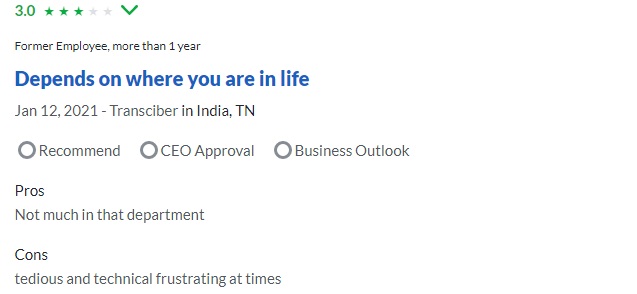
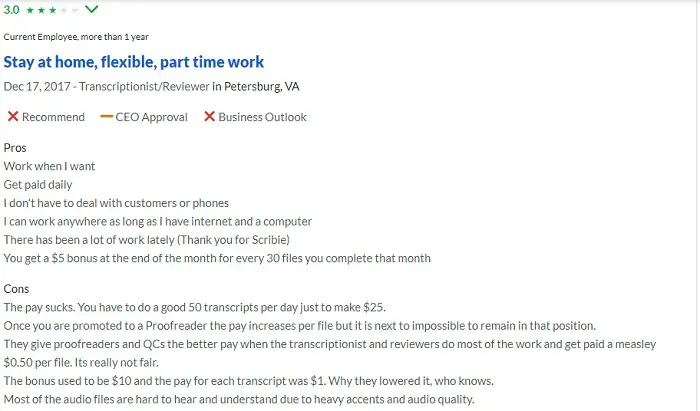
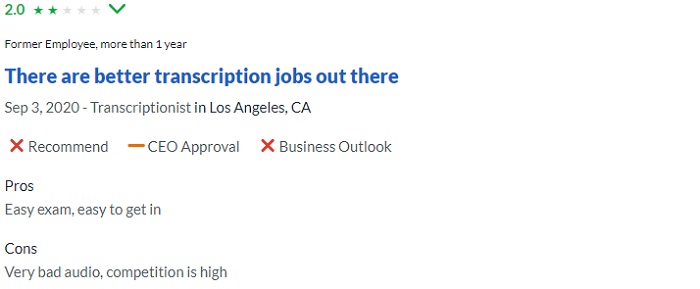
After 128 votes, Scribie has a so-so 3.3-star rating on Glassdoor.
Rev
Common complaints about Rev include:
- Poor/inconsistent pay per audio hour
- Poor audio quality
- Insufficient support staff
- Few projects for beginners
- High turnover rate
- Sudden unexplained account closure
- Inaccessibility from some regions
Reviewers had this to say:
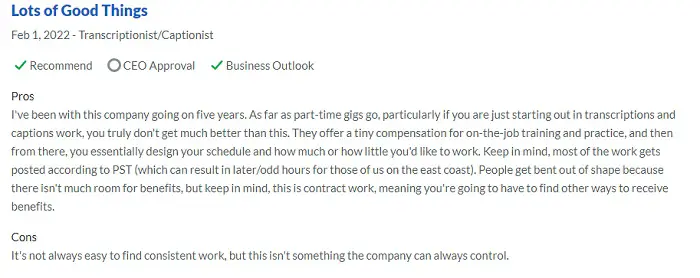
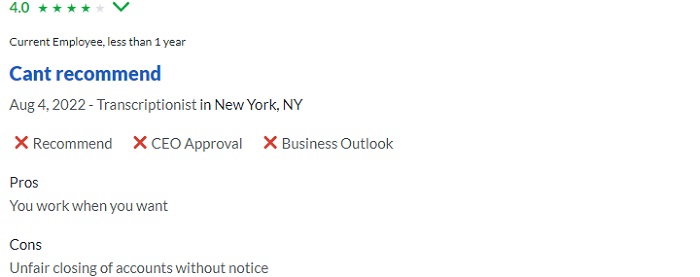
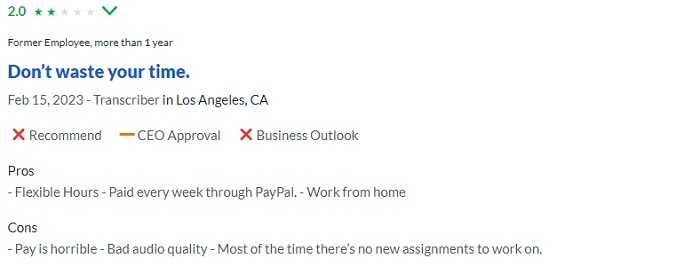
Rev has an average Glassdoor rating of 3.8 stars after over 2,000 reviews.
A point to note is that reviews may not be the exact way to settle the Scribie vs. Rev debate.
Most of the highlighted cons are across the board, meaning they are transcription problems as opposed to a specific platform’s problems.
Additionally, and this should go without saying, people lose their patience quickly.
Some sign up for these platforms with unrealistic expectations, and others wouldn’t even know, let alone acknowledge, when they are the problem.
Who Is Scribie For?
Scribie is for anyone who is ready to start from scratch and build their transcription career gradually.
The reason for this is that you get nine application attempts in case the initial one fails.
Those are enough second chances to let you know if you are even good enough to be a transcriber.
The site may not offer the best rates, but at least it promises promotions. Better roles come with better pay rates and less competition.
Who Is Rev For?
Rev is the more popular option in this debate. However, that doesn’t automatically make it the better choice.
If you are outside what is considered native English-speaking countries, you cannot sign up.
Beyond that, the site wins on virtually every other aspect. For one, you will be paid more per audio hour and receive more work.
You will also have the chance to hop on captioning and translation tasks whenever a good opportunity pops up.
You could say Rev is for anyone that knows their way around transcription and lives where the site is available.
Scribie Vs. Rev: Verdict
These points should help guide your decision:
- Rev accepts applications from specific locations, while Scribie will take you in as long as PayPal is available in your country.
- Rev lets you reapply after 45 days following a rejection, while Scribie gives you ten takes that have no timeline attached to them.
- Rev has more work to offer, given it serves 100,000 customers with only 15,000 transcribers. Scribie’s clients outnumber transcribers by just a few thousands, meaning competition for work is significantly higher.
- Rev has transcription, captioning, and subtitle translation assignments. Captioning and translation pay even more, making them a great substitute for when there is a dry spell in the transcription marketplace.
- Scribie lets you withdraw your earnings at any time, regardless of the amount you’ve accumulated. Rev pays once every week.
While Scribie has its upsides, Rev seems to blow it out of the water on the more important fronts. So, I’ll go with Rev as the winner of this comparison.
Let me know what you think in the comments.












